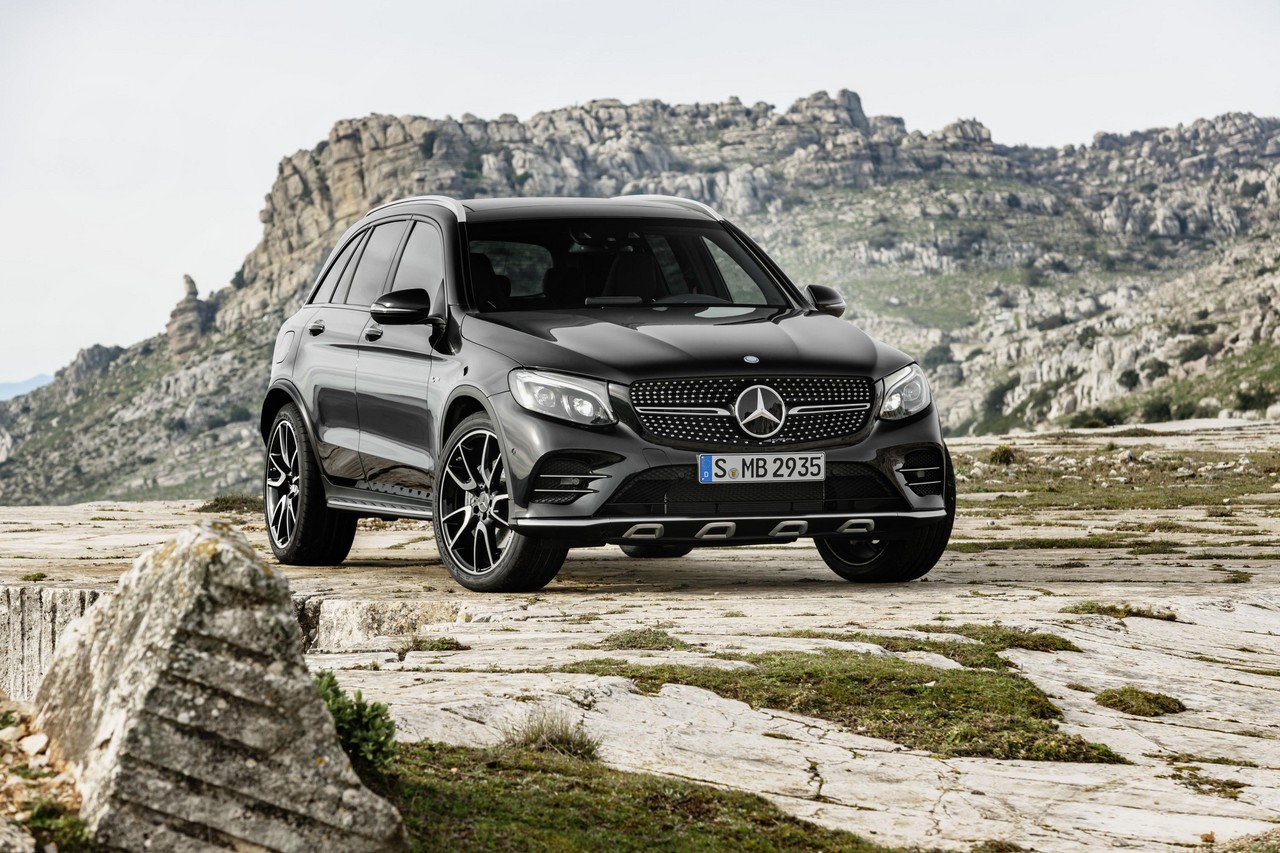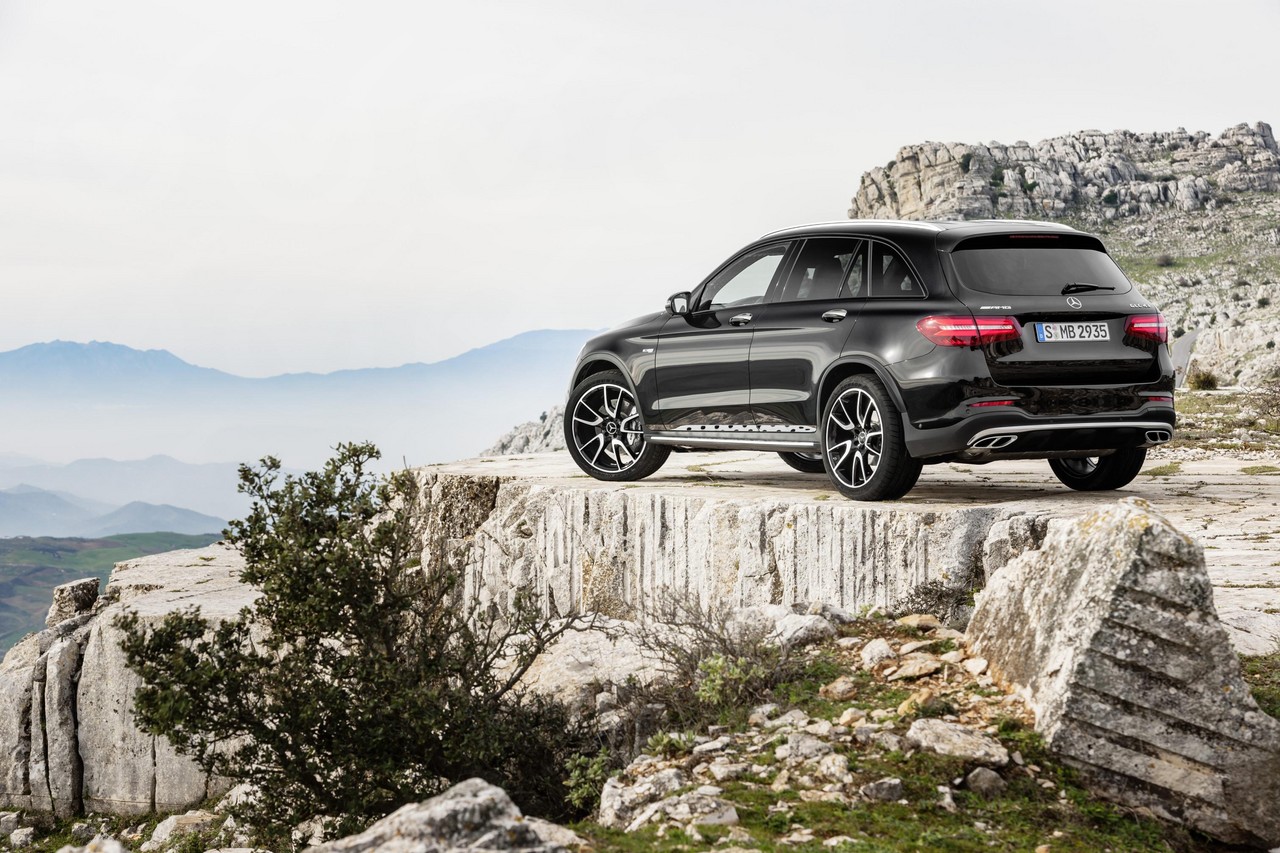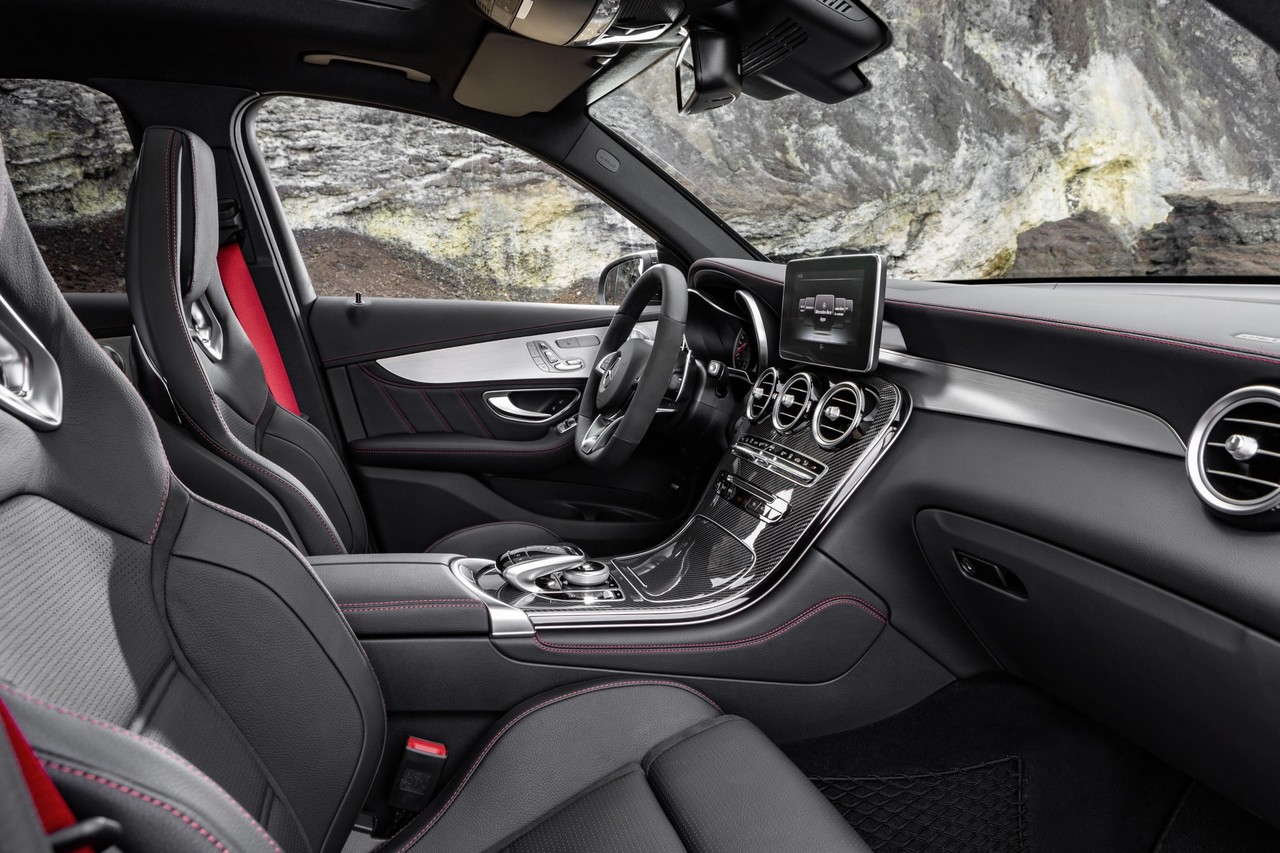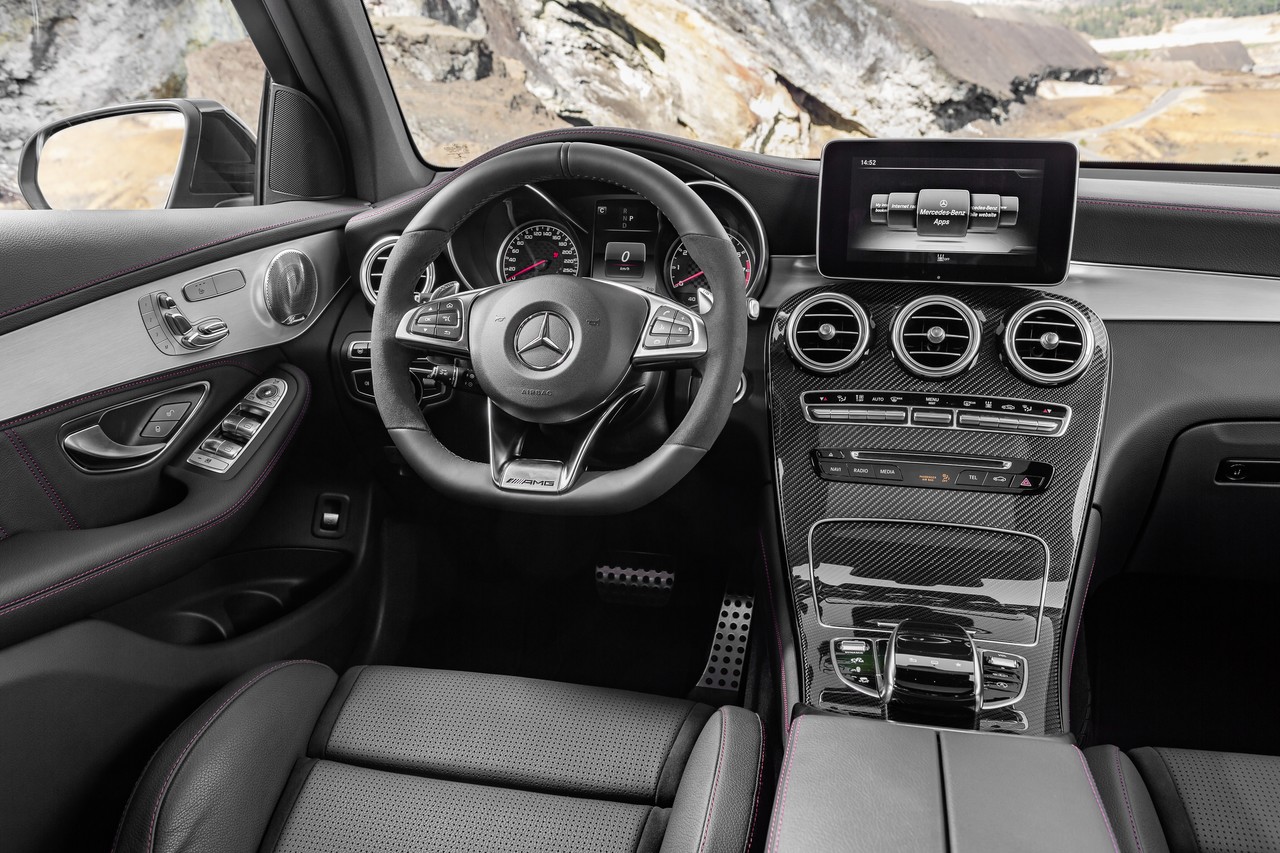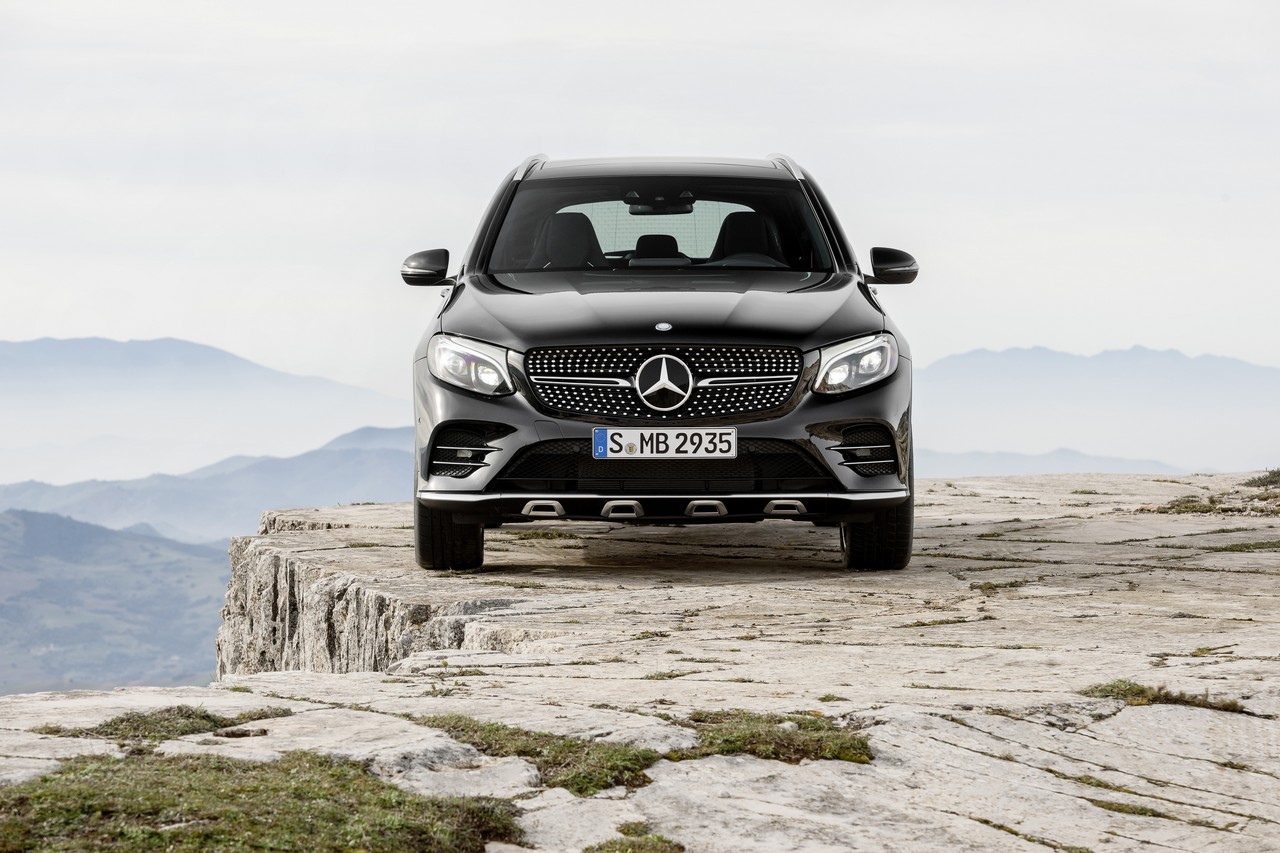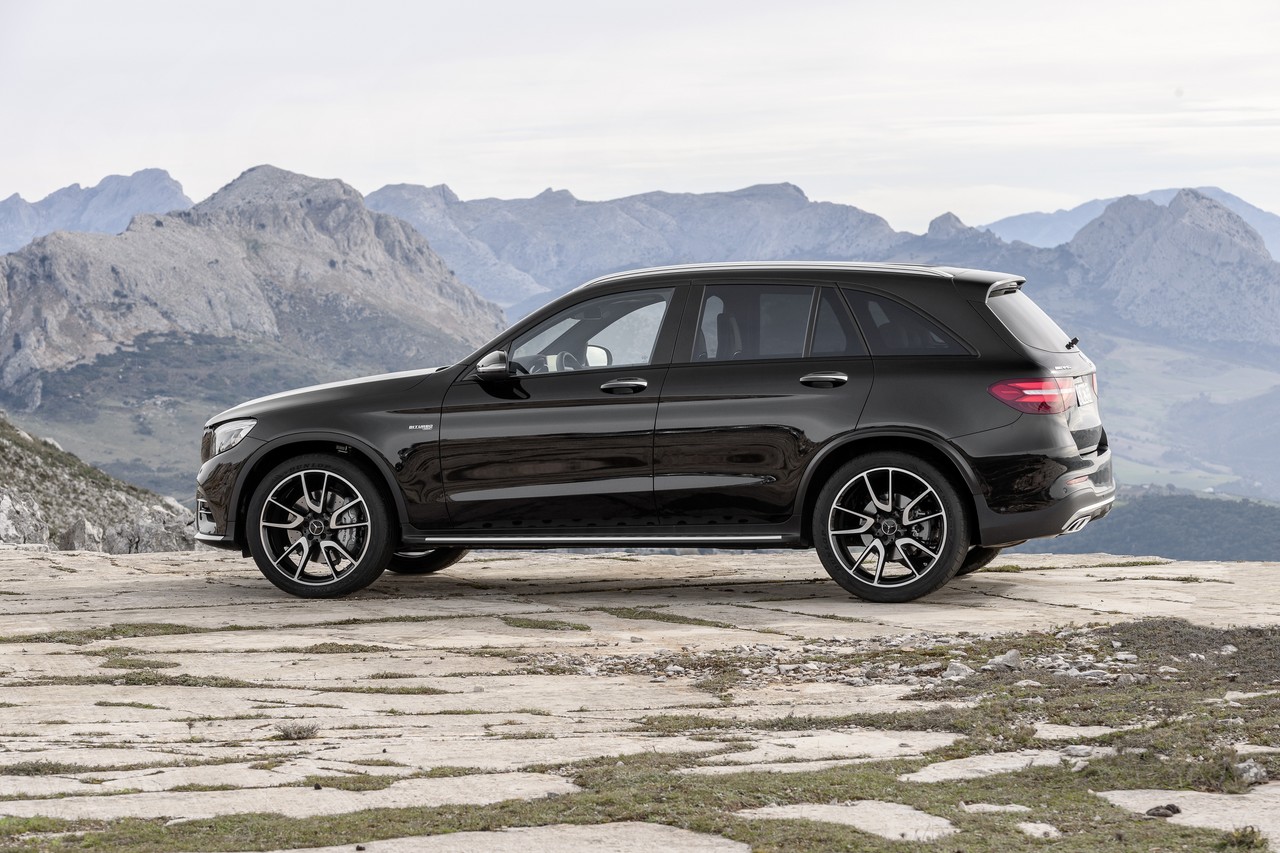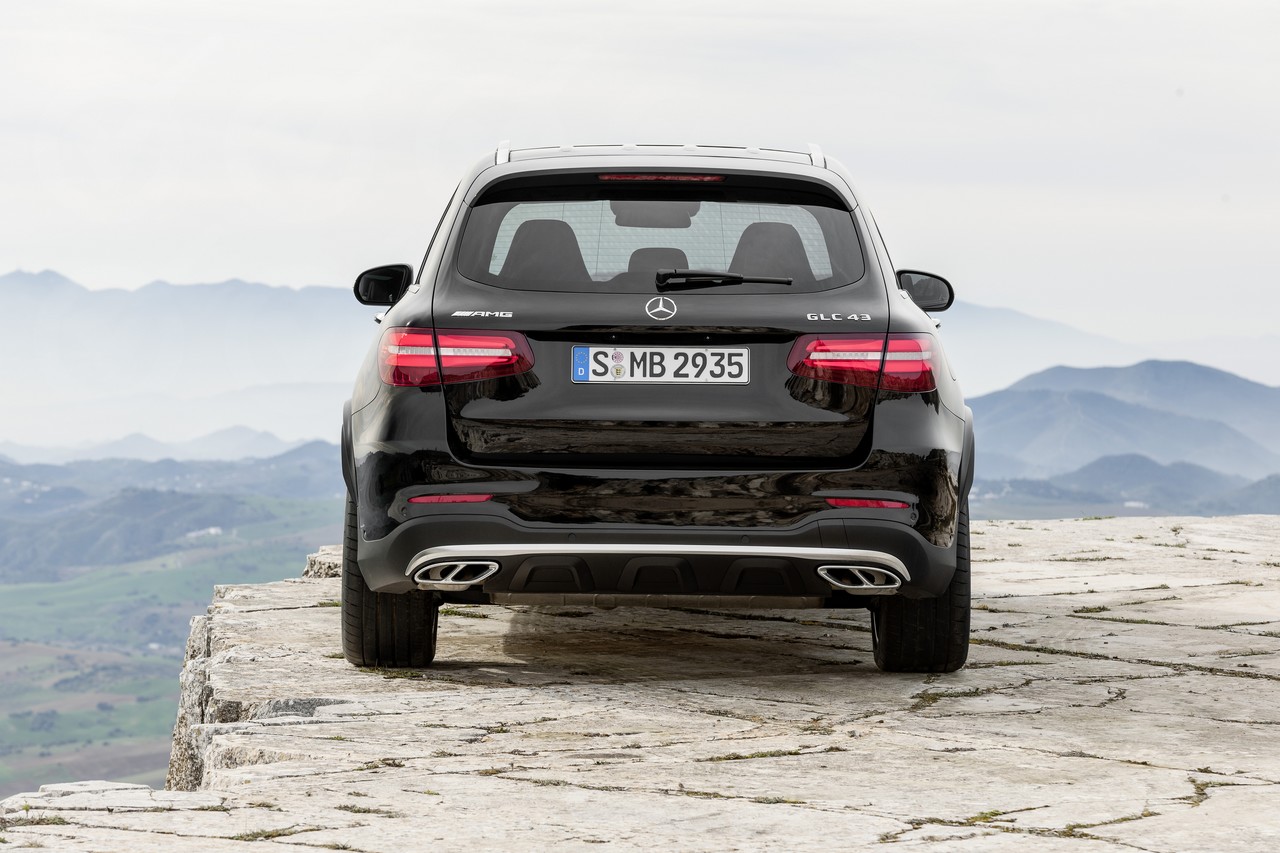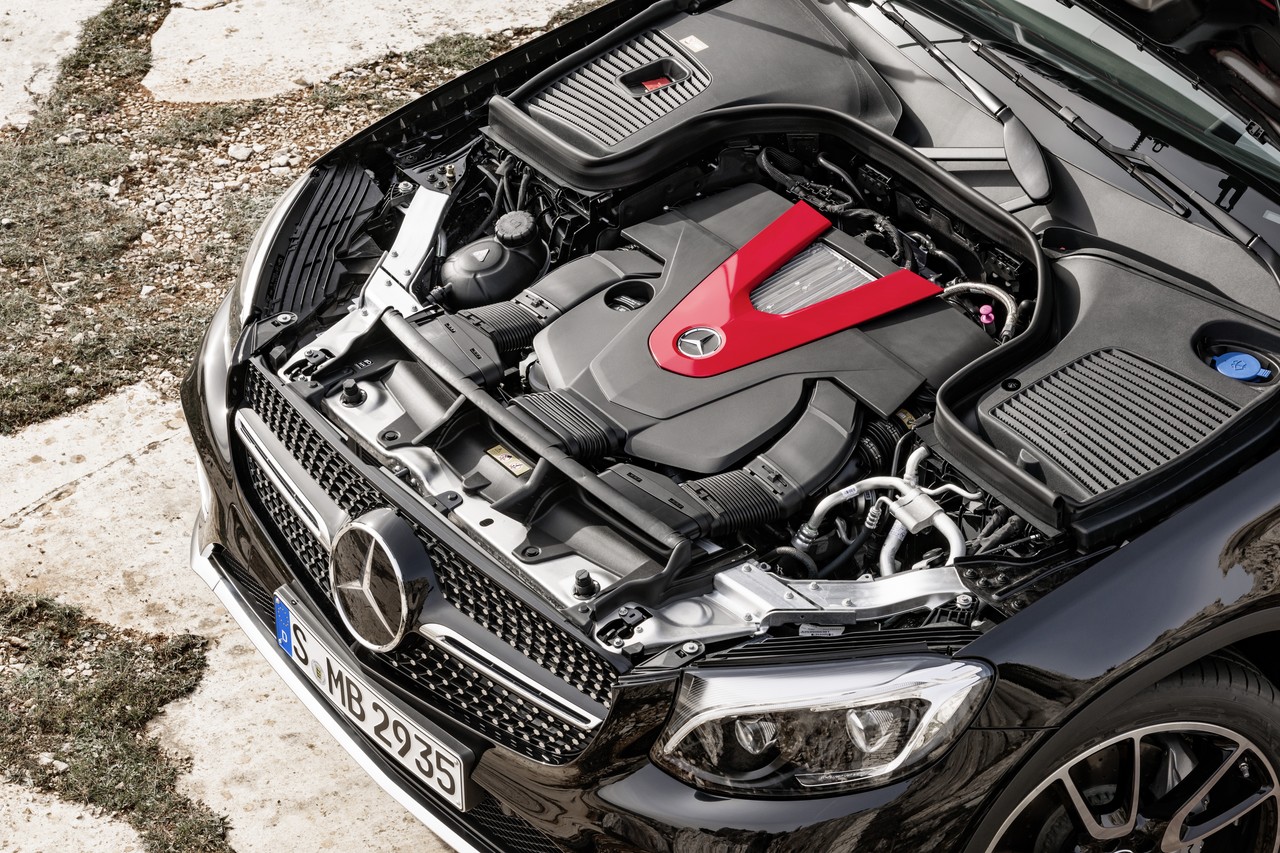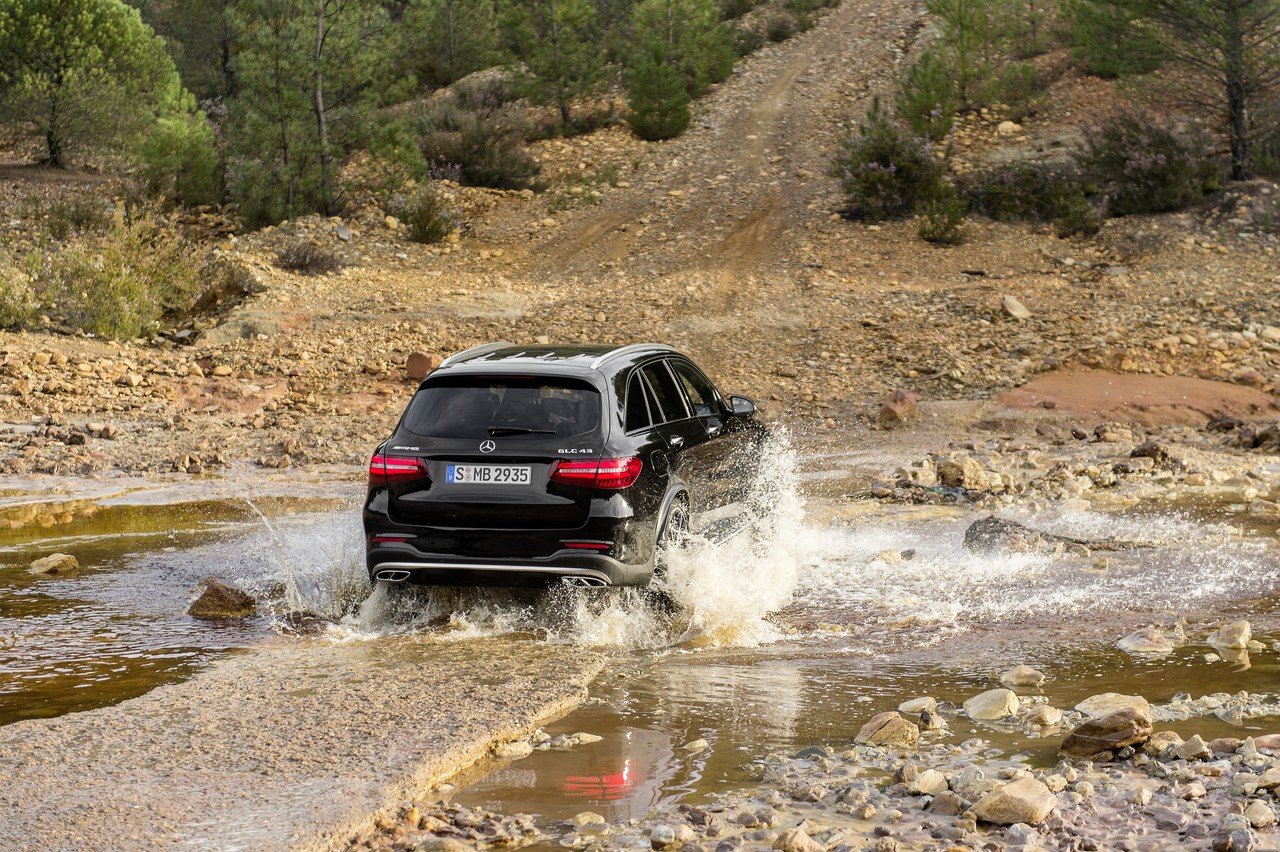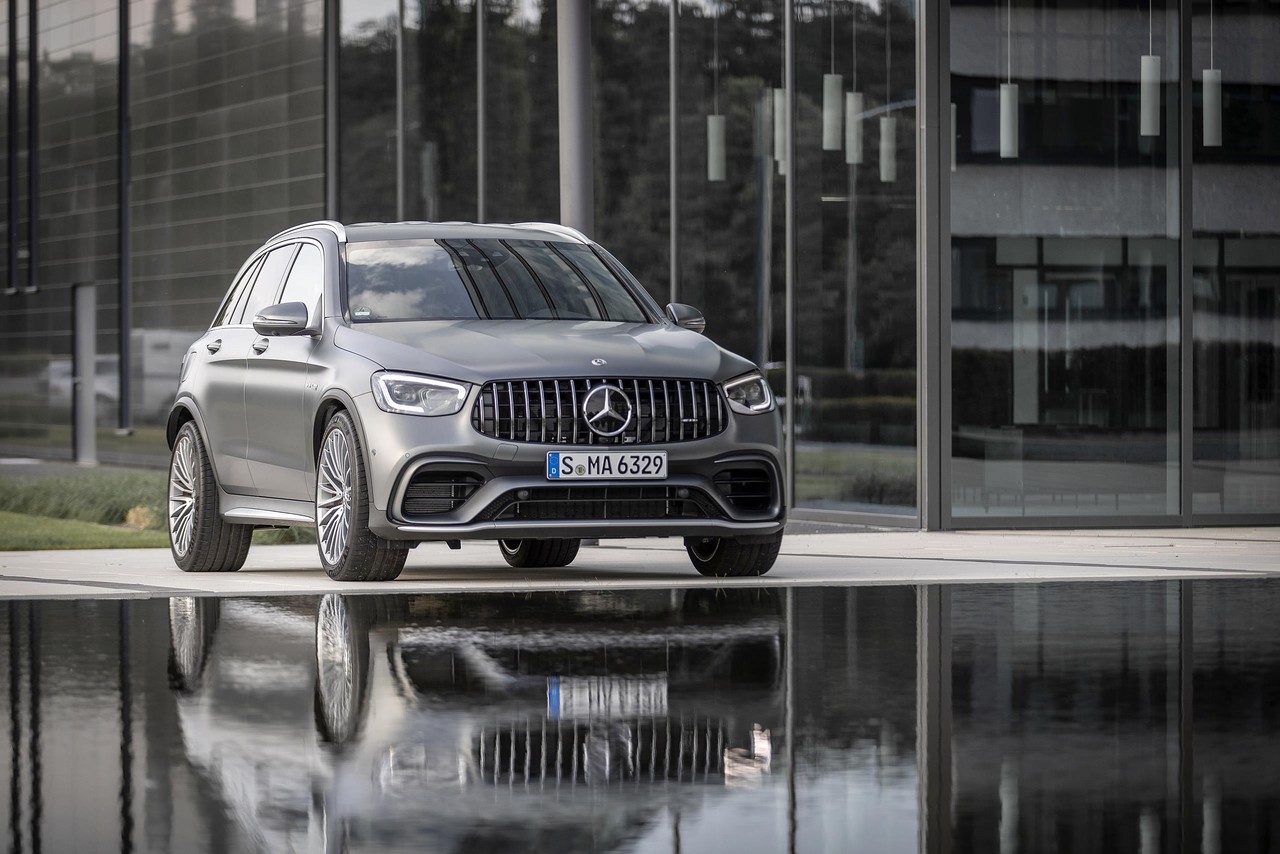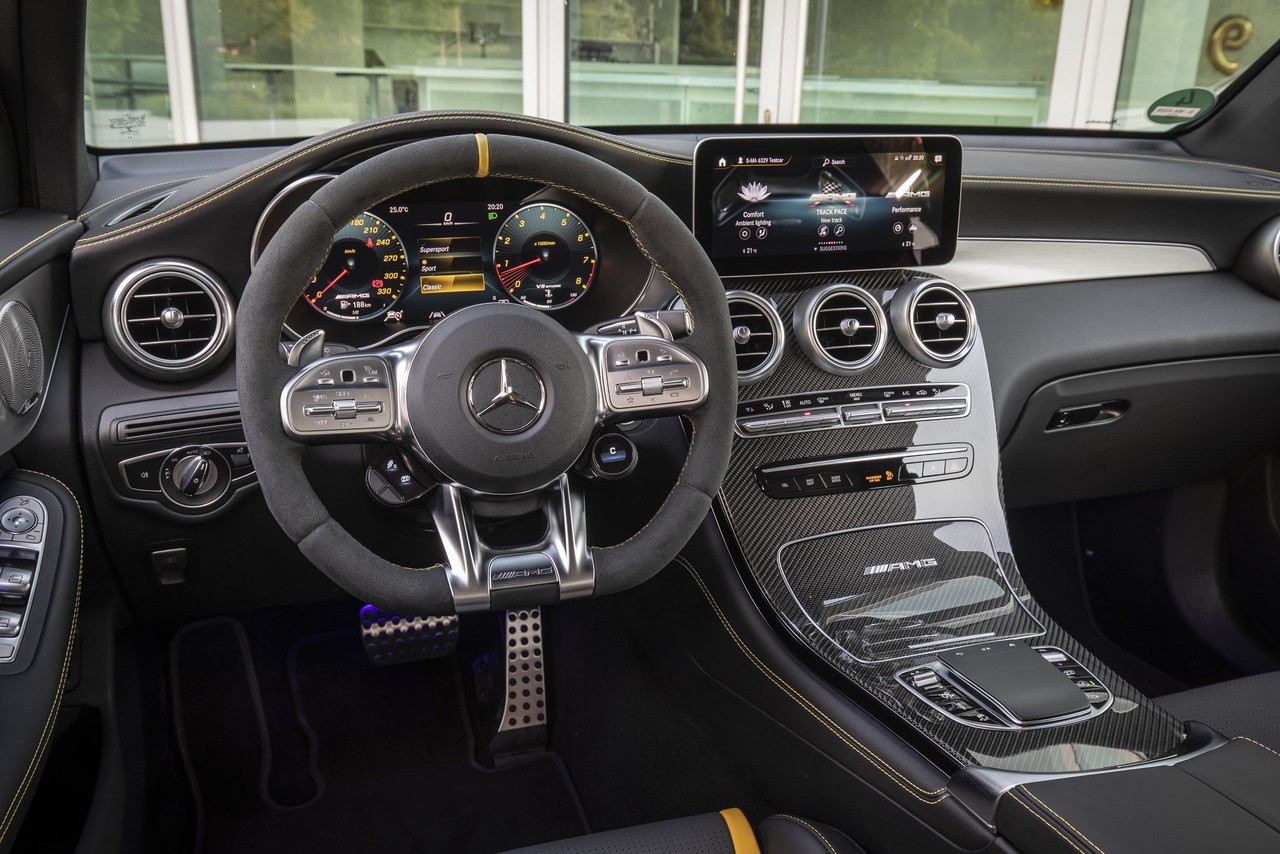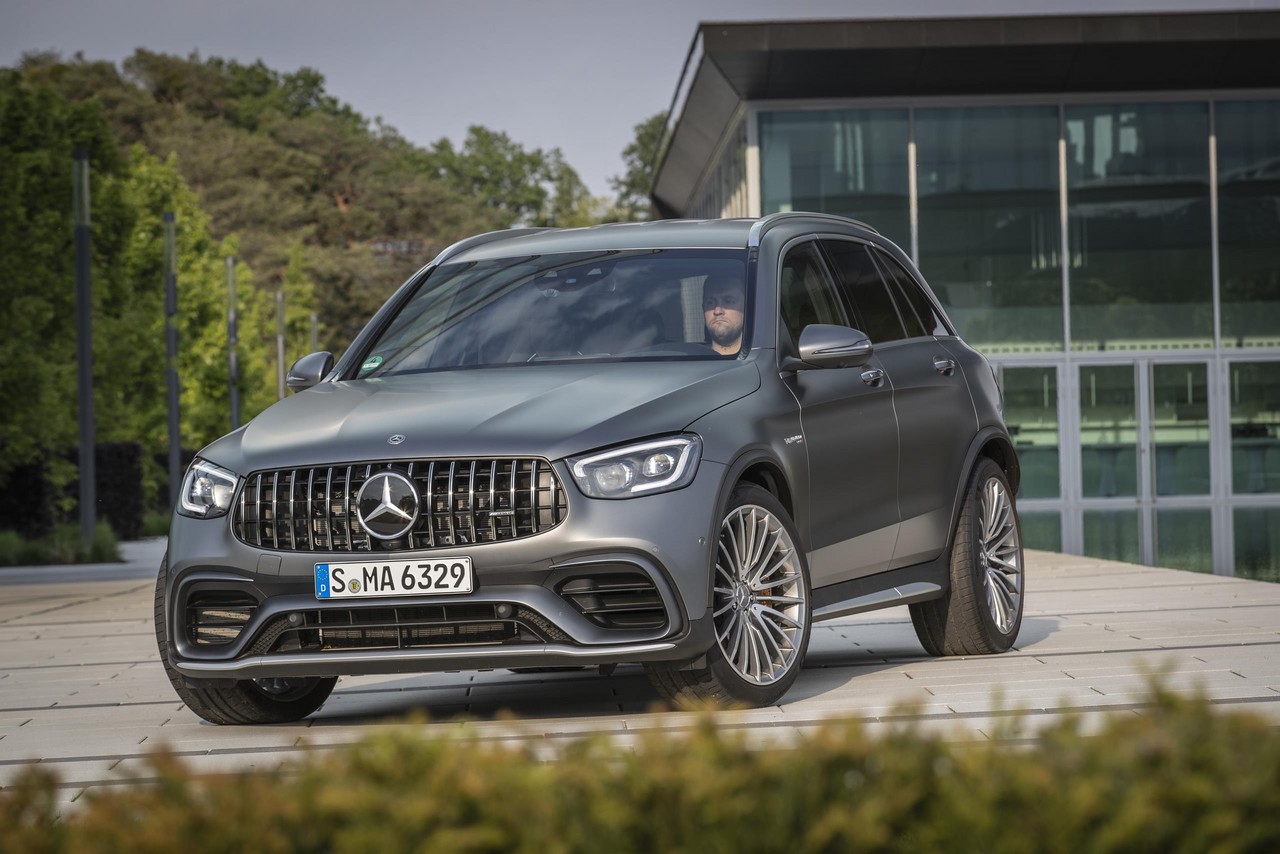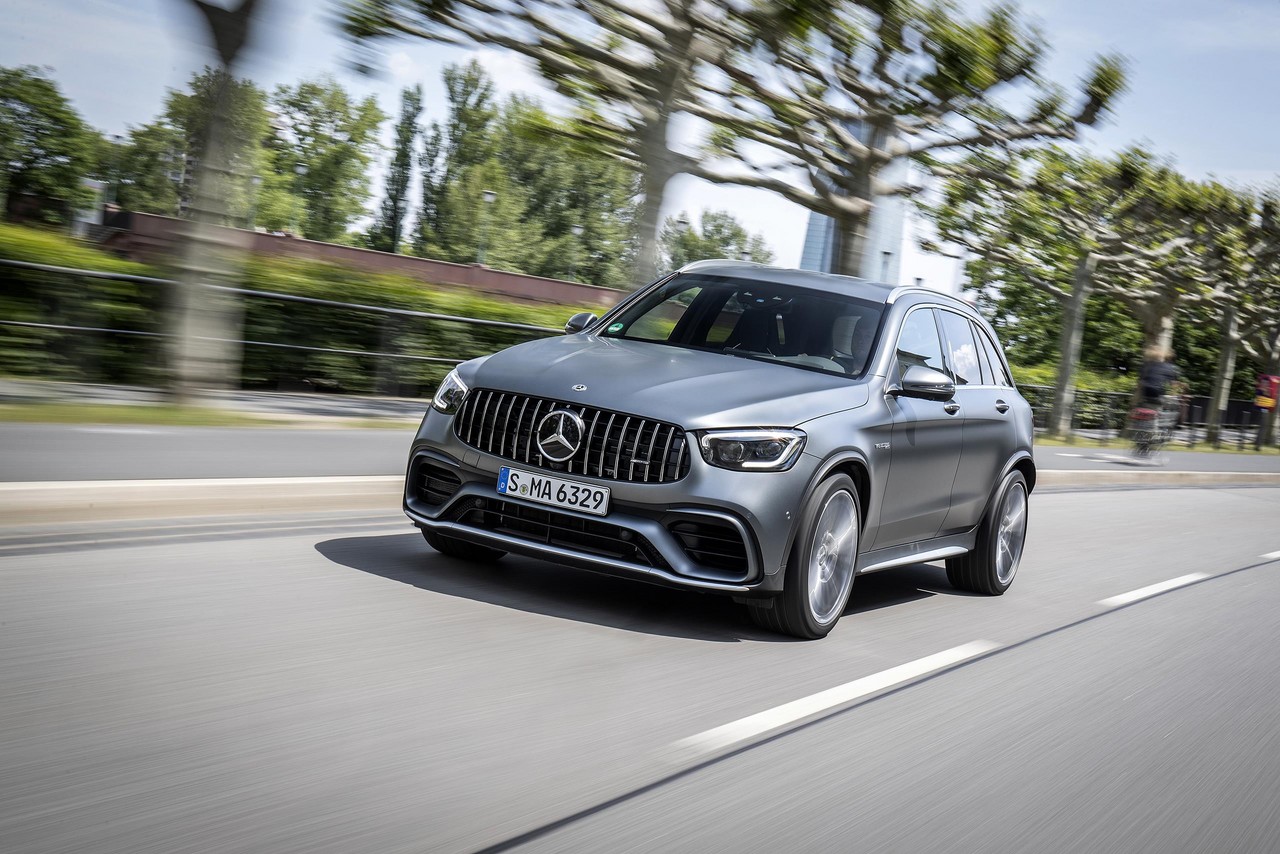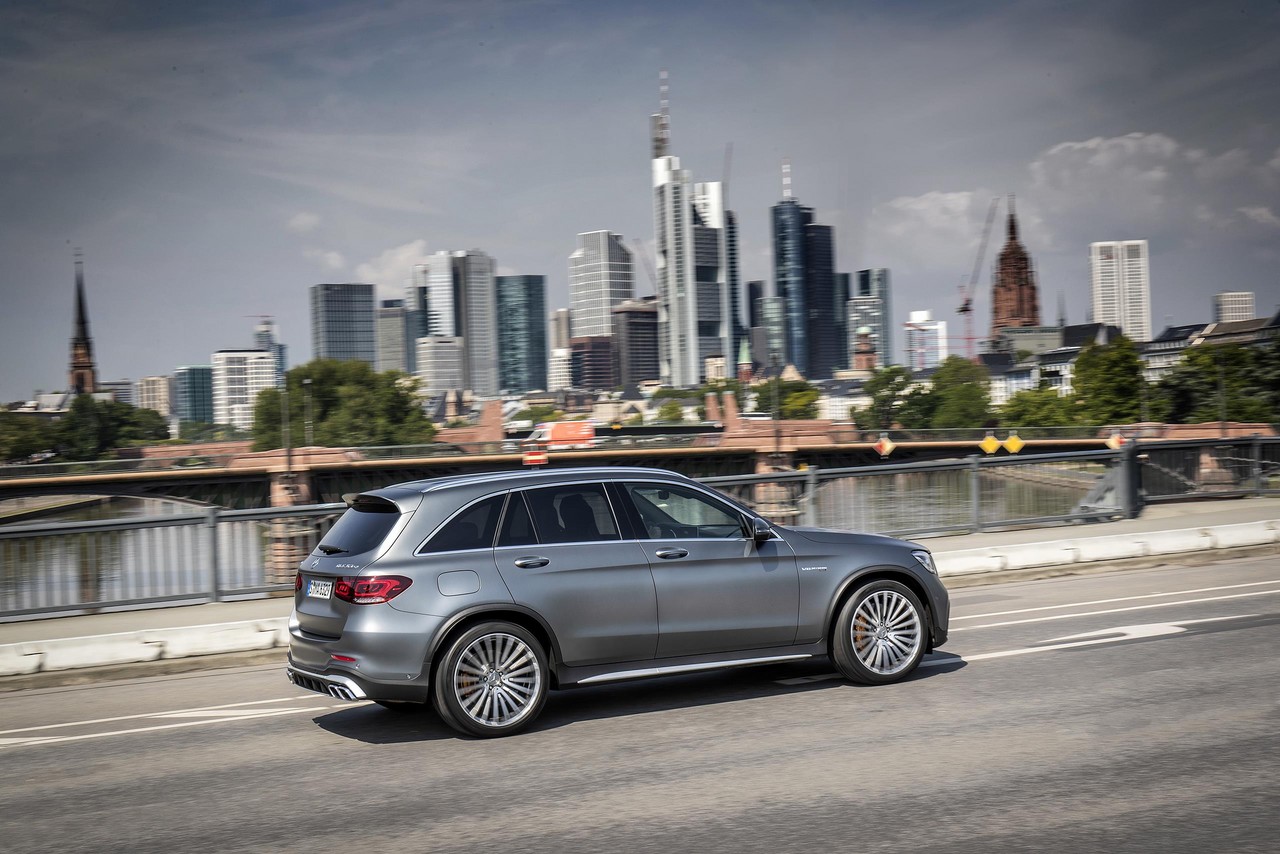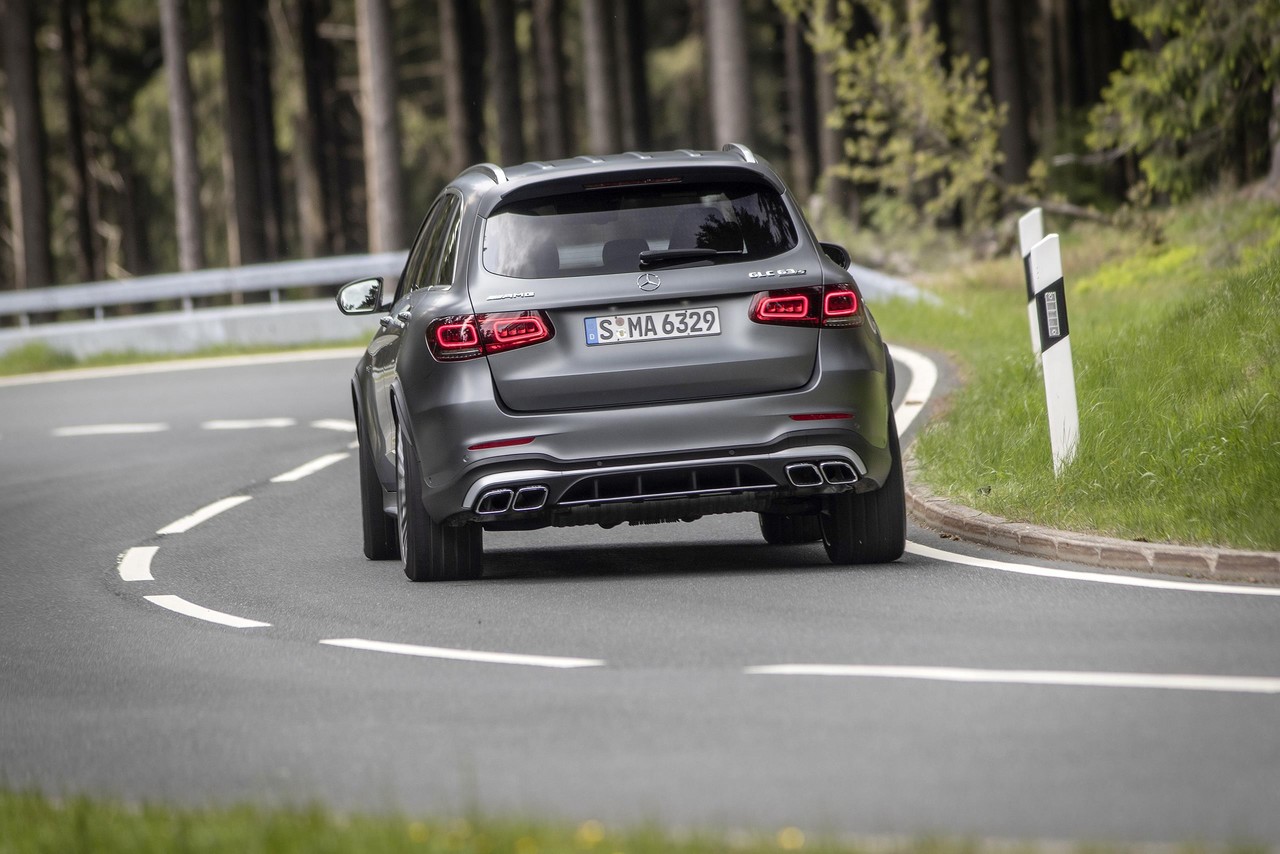
- For GLC 43, responsive 3.0-litre M276 biturbo V6 petrol engine
- For GLC 63 S, powerful 4.0-litre M177 biturbo V8 petrol engine
- Accomplished dynamics
- High standard of interior fit and finish
- For GLC 43, front-end judder, tyre skip and thump noises due to steering geometry
- Suspension lacks compliance
Review: Mercedes-AMG X253.I GLC (2016-19)
Overview
Released in Australia in December 2016, the Mercedes-AMG X253 GLC 43 was a mid-size SUV. Manufactured in Bremen, Germany, the all-wheel drive Mercedes-AMG GLC 43 was powered by a 3.0-litre biturbo V6 petrol engine that was mated to a nine-speed automatic transmission (Mercedes’ ‘9G-Tronic’).
In April 2017, production of the Mercedes-AMG X253 GLC 63 S commenced. The GLC 63 S was powered by a 4.0-litre biturbo V8 petrol engine that was mated to a nine-speed semi-automatic transmission.
| Engine | Trans. | Peak power | Peak torque | |
|---|---|---|---|---|
| GLC 43 | 2996 cc M276 biturbo petrol V6 | 9sp auto | 270 kW at 5500-6000 rpm | 520 Nm at 2500-4500 rpm |
| GLC 63 S | 3982 cc M177 biturbo petrol V8 | 9sp semi-auto | 375 kW at 5500-6250 rpm | 700 Nm at 1750-4500 rpm |
GLC 43: Biturbo M276 V6 engine and 9G-Tronic transmission
The Mercedes-AMG GLC 43 was powered by the 2996 cc M276 V6 engine which had an aluminium alloy block and cylinder head, ‘Nanoslide’ cylinder wall coatings, a forged steel crankshaft, an IHI turbocharger for each cylinder bank which provided peak boost pressure of 1.1 bar, double overhead camshafts (chain-driven), independent intake and exhaust camshaft adjustment, four valves per cylinder, direct injection via piezo injectors at a pressure of up to 200 bar, a variable-resonance intake manifold and a compression ratio of 10.7:1.
To reduce fuel consumption, the M276 engine had an ECO start/stop function which enabled it to shut down when the GLC 43 was stationary in traffic. Over the combined ADR 81/02 test cycle, fuel consumption for the Mercedes-AMG X253 GLC 43 was 8.8 litres per 100 km.
For the GLC 43, Mercedes developed unique software for the 9G-Tronic transmission to deliver faster gearshifts. The transmission had a multiple downshift function and the driver could select from Eco, Comfort, Sport, Sport Plus and Manual modes for different transmission gearshift mapping and shift speeds. In ‘Eco’ mode, the clutch could disengage to decouple the engine from the powertrain when the driver released the accelerator and the GLC 43 was travelling between 60 km/h and 160 km/h; when this occurred, engine speed was reduced to idle and the driving resistance was reduced by the compression and frictional forces of the engine in over-run mode.
In the ‘Sport’ and ‘Sport Plus’ modes, the 9G-Tronic transmission provided:
- A double-declutching function; and,
- Ignition adjustments for faster gearshifts.
In Manual mode, the driver could change gear using the paddles on the steering wheel and the transmission would stay in the selected gear until engine speed reached its rpm limit.
GLC 63 S: Biturbo M177 V8 engine and AMG Speedshift MCT 9-speed transmission
Assembled by hand in Affalterbach, the 3982 cc M177 V8 engine for the GLC 63 S had a cast aluminium closed-deck block, ‘Nanoslide’ cylinder wall coatings, zirconium alloy cylinder heads, two turbochargers mounted within the engine’s ‘V’ providing maximum boost pressure of 1.2 bar (17.4 psi), double overhead camshafts, variable inlet and exhaust valve timing, four valves per cylinder, direct fuel injection via piezo injectors, a compression ratio of 10.5:1 and dry sump lubrication.
Like the biturbo M276 engine, the M177 V8 engine had an ‘ECO start/stop’ function. Furthermore, the clutch of the AMG Speedshift transmission could open when the ‘Comfort’ drive mode was selected to decouple the engine from the drivetrain if the driver lifted their foot off the accelerator at speeds between 60 km/h and 160 km/h.
The nine-speed ‘AMG Speedshift MCT’ (Multi Clutch Technology) had multiple clutches that were placed together and controlled separately. As such, the AMG Speedshift MCT had a compact, wet start-up clutch that operated in an oil bath rather than a conventional torque converter; unlike double clutch transmissions, the SpeedShift MCT had a single input shaft. Features of the AMG Speedshift transmission included:
- Automatic throttle-blipping on downshifts;
- A double-declutching function for multiple downshifts;
- A ‘sailing’ function. When the driver released the accelerator at speeds between 60 km/h and 160 km/h, the clutch of the MCT opened to decouple the engine from the powertrain. Furthermore, electronics reduced engine speed to idling level and motion resistance was reduced by the compression and frictional forces of the engine in overrun mode; and,
- A ‘Race Start’ function.
4MATIC all-wheel drive systems
For the Mercedes-AMG X253 GLC 43, the ‘4MATIC’ all-wheel drive system utilised a centre planetary differential and multiple-disc clutch, with the single-stage transfer case flange-mounted on the nine-speed ‘9G Tronic’ automatic transmission. In normal conditions, the 4MATIC system provided a 31:69 front:rear torque split (compared to 45:55 for the Mercedes-Benz X253 GLC ).
For the Mercedes-AMG X253 GLC 63 S, the ‘4MATIC+’ permanent all-wheel drive system utilised an electromechanically controlled coupling to connect the permanently driven rear axle to the front axle. According to Mercedes,
- The optimum front:rear torque distribution was continuously calculated according to the driving conditions and driver’s input; and,
- The torque distribution for the front and rear axles was fully variable.
The Mercedes-AMG X253 GLC 63 S was also fitted with an electronically controlled rear-axle limited slip differential (LSD).
Dimensions
The Mercedes-AMG X253 GLC 43 was 4668 mm long, 1890 mm wide, 1638 mm tall and had a 2873 mm long wheelbase; its ground clearance was 193 mm. For Australian-delivered vehicles, the GCL 43 had an unladen (tare) mass of 1912 kg.
Suspension
The Mercedes-AMG X253 GLC had four-link front suspension and a five-link rear axle.
Compared to the Mercedes-Benz X253 GLC , the front-axle for the Mercedes-AMG GLC 43 was fitted with special steering knuckles and load-bearing joints on the spring link; negative camber was also increased for both front and rear axles. Furthermore, the suspension included Mercedes-Benz’s ‘Air Body Control’ multi-chamber air suspension which consisted of:
- Two chambers of different sizes in the spring struts of the front axle; and,
- Three chambers of different sizes in the spring struts of the rear axle.
The Air Body Control suspension adjusted, in three stages, how stiffly the suspension reacted. Air Body Control also included a continuously operating, electronically controlled damping adjustment system which adjusted damping at each individual wheel according to the driving situation (including evasive manoeuvres) and road conditions.
The Air Body Control suspension included all-round self-levelling which adjusted ride height according to vehicle speed, enabling it to reduce the vehicle’s aerodynamic drag and therefore fuel consumption. When driving on rough roads, ground clearance could also be increased via the ride height adjustment switch. Furthermore, the ‘ADS Plus’ adaptive damping system enabled the driver to select from ‘Comfort’, ‘Sport’ and ‘Sport Plus’ modes.
Steering
The Mercedes-AMG GLC had rack-and-pinion steering with electric power assistance.
Safety equipment
Standard safety equipment for the Mercedes-AMG X253 GLC included dual front airbags, a driver’s knee airbag, front and rear side (thorax/pelvic) airbags, full-length curtain airbags, ABS, electronic brake force distribution, brake assist, electronic stability control, traction control and front seatbelts with pre-tensioners and load limiters.
As standard, the Mercedes-AMG X253 GLC 43 and 63 S were also equipped with:
- Mercedes-Benz’s ‘Pre-Safe’ which prepared the vehicle for a collision by deploying the seatbelt tensioners, closing the side windows and sunroof (where fitted) and adjusting the front seats for optimum deployment of the restraint system. Pre-Safe was activated by emergency braking, panic braking, pronounced over- or under-steering, critical steering movements or heavy support by the adaptive Brake Assist system;
- Collision Prevention Assist Plus (radar-based collision warning with autonomous braking and adaptive Brake Assist): operating at speeds up to 250 km/h to monitor the traffic ahead and at speeds up to 50 km/h for stationary objects, Collision Prevention Assist would issue a visual warning (when driving at speeds over 7 km/h) and an optical warning (when driving at speeds over 30 km/h if there was a collision risk. At speeds below 105 km/h (250 km/h in conjunction with Distronic Plus), Collision Prevention Assist Plus would initially provide partial autonomous braking to reduce vehicle speed and alert the driver. Furthermore, adaptive Brake Assist would calculate the braking force required and prime the braking system for optimum response when the driver depressed the brake pedal. If the driver did not respond and a collision was unavoidable, then maximum braking force would be applied to reduce vehicle speed. At initial vehicle speeds of up to 40 km/h, rear-end collisions could be prevented;
- Distronic Plus (adaptive cruise control with brake warning): an ‘adaptive’ cruise control system which used two short-range radar sensors positioned behind the front bumper to monitor the road up to 30 metres ahead, and a long-range radar located behind the radiator grille which had a range of 200 metres. Operating at speeds up to 200 km/h, Distronic Plus used an electronic control unit to analyse the information from both radar systems to calculate the engine, automatic transmission and braking parameters required for proximity control. As such, Distronic Plus could automatically apply the brakes to prevent the vehicle from becoming too close to traffic ahead (the time interval could be specified) and accelerate back to the set speed when traffic allowed. To accelerate from rest, the driver only needed to operate the Distronic stalk on the steering column or briefly depress the accelerator pedal. With Distronic Plus, automatic deceleration of up to four (4) m/s2was possible. If Distronic Plus detected that heavier braking was required, a warning light would illuminate in the instrument cluster and be accompanied by an audible warning. Furthermore, the electronic proximity control system could be activated independently of Distronic Plus at speeds over 30 km/h to alert the driver if they were approaching another vehicle too rapidly;
- Steering Assist with Stop&Go Pilot: operating in conjunction with Distronic Plus and at speeds up to 130 km/h, Steering Assist used a stereo camera located behind the windscreen to detect road markings, while the Stop&Go Pilot operated at speeds up to 60 km/h and enabled the system to use the vehicle in front or road markings as a means of orientation. If the vehicle was detected to be drifting out of its lane, Steering Assist would warn the driver and provide steering intervention to keep the vehicle in its lane;
- Pre-Safe Brake with pedestrian detection (autonomous emergency braking): using two 24 GHz sensors behind the front bumper which had a range of 30 metres and a 77 GHz radar which had a range of 200 metres, Pre-Safe Brake operated at speeds between 30 km/h and 200 km/h, and at speeds below 70 km/h if the vehicle was approaching a stationary queue of traffic. Around 2.6 seconds before the anticipated moment of impact, an audible warning would sound and a red warning would appear in the tachometer. Around 1.6 before the calculated impact, the first stage of Pre-Safe Brake would initiate partial braking autonomously with around 40 per cent of the maximum braking power (approximately four (4) m/s2); the Pre-Safe occupant protections system would also be activated. If the driver then applied the brakes, maximum braking force would be made available. If the driver failed to react, Pre-Safe Brake would – in its second stage – initiate autonomous emergency braking (i.e. maximum braking power) around 0.6 seconds before the unavoidable collision to reduce the severity of the impact. The pedestrian recognition function enabled Pre-Safe Brake to detect pedestrians when driving at speeds of up to 50 km/h;
- Pre-Safe Plus: could anticipate rear-end collisions and warn following traffic by activating the rear hazard lights at high frequency. The Pre-Safe system would then deploy occupant protection measures and apply the vehicle’s brakes to prevent secondary accidents;
- BAS Plus with Cross-Traffic Assist: used a 24 GHz radar sensor with a range of 30 metres and a 77 GHz radar sensor with a range of 200 metres to monitor the distance to the vehicle ahead and would warn the driver if there was a risk of a collision. Brake Assist Plus could detect vehicles when travelling at speeds up to 200 km/h, and stationary objects when the driver was travelling at 7 km/h to 72 km/h. Significantly, Brake Assist Plus could calculate the necessary brake force assistance to prevent a rear-end collision, build up that pressure in the braking system and provide it as soon as the brake pedal was depressed for ‘the best possible deceleration’. The Cross-Traffic Assist function could operate at speeds up to 72 km/h and used the stereo camera and radar sensors to detect traffic that was crossing in front of or behind the vehicle. If detected, the driver would receive visual and audible alerts;
- Blind spot assist (passive) which used two radar sensors in the rear of the vehicle to warn the driver before an indicated lane-change if a vehicle was in the driver’s blind spot;
- Active Blind Spot Assist: an extension of Blind Sport Assist, Active Blind Spot Assist could apply the brakes on one side of the vehicle to counter-act a driver’s attempt to change lanes when it was not safe to do so;
- Active Lane Keeping Assist: could detect when the adjacent lane was occupied (including oncoming traffic) and prevent the driver from inadvertently exiting from the lane when it was not safe to do so by applying a corrective braking force to the wheels on one side of the vehicle; and,
- Attention Assist which operated at speeds in excess of 80 km/h and assessed driver behaviour and steering movements for signs of drowsiness; if detected, the driver would be provided with visual and audible warnings.
Euro NCAP testing
In Euro NCAP testing , a 2015 Mercedes-Benz X253 GLC 220d 4MATIC received a five star safety rating which included a 95 per cent adult occupant protection rating and an 89 per cent child occupant rating. In the frontal offset test, occupant protection was generally rated as good, although chest and lower right leg protection was rated as adequate (i.e. a slight risk of serious injury). In the side impact and pole tests, however, maximum points were awarded.
Wheels, tyres and brakes
The Mercedes-AMG GLC 43 had 8.5J x 21-inch five-twin-spoke front alloy wheels with 255/40 ZR21 tyres and 9.5J x 21-inch rear alloy wheels with 285/35 R19 tyres. Furthermore, the five-spoke AMG light-alloy wheels had bi-colour black finish.
The Mercedes-AMG GLC 43 had 360 mm by 36 mm internally ventilated and perforated compound brake discs with four-piston fixed callipers and 320 mm by 24 mm internally ventilated rear discs with single-piston fixed callipers.
The Mercedes-AMG X253 GLC 63 S Coupe, however, had 21-inch AMG five-twin-spoke alloy wheels painted in black. The 9.5J x 21-inch front wheels had 265/40 ZR21 tyres, while the 10.0J x 21-inch rear wheels had 295/35 ZR21 tyres.
Features: Mercedes-AMG X253 GLC 43
As standard, the Mercedes-AMG X253 GLC 43 was equipped with the COMAND Online infotai Nment system which included a 21.3 cm TFT display, HDD navigation system with traffic messaging channel, CD/DVD player, 10 GB music register, Bluetooth mobile phone connectivity and audio streaming, ‘Linguatronic’ voice recognition and Internet access. Furthermore, the GLC 43 had a 590 watt Burmester surround sound system with a nine-channel digital sound processing (DSP) amplifier and thirteen speakers, digital radio tuner (DAB+ and MP3/WMA/ACC compatibility.
Additional standard features for the Mercedes-AMG X253 GLC 43 included dual-zone climate control air conditioning, leather upholstery, power adjustable and heated front seats, cruise control, LED headlights, automatic headlights, rain-sensing wipers, front and rear parking sensors, 40:20:40 folding rear seats, a flat-bottomed sports steering wheel with gearshift paddles, remote central locking with proximity key (i.e. ‘keyless entry), power windows, power adjustable and heated door mirrors with folding function, tilt and telescopic steering wheel adjustment, a head-up display (HUD), an auto-dimming rear view mirror, push-button start, power-operated tailgate, push-button start (‘keyless go’), driver memory settings (for the seats, door mirrors and steering wheel), ambient lighting, 12 volt power sockets, synthetic leather (‘Artico’) dashboard trim, AMG floor mats, stainless steel pedals, illuminated front door sill panels, rear privacy glass, tyre pressure monitoring system, a trip computer, alarm and immobiliser.
Shared with the Mercedes-Benz X253 GLC, the GLC 43 was also fitted with the following –
- Active Parking Assist: could identify parallel and right angle parking spaces – at speeds of up to 35 km/h – and automatically steer the vehicle into the space;
- Mercedes-Benz’s ‘LED Intelligent Light System with Adaptive Highbeam Assist Plus’: allowed the main LED beam to remain on since an area of that beam can be masked out for oncoming traffic; and,
- A 360 degree camera system which could show the GLC and its surroundings from different perspectives.
Visual cues for the Mercedes-AMG X253 GLC 43 included its diamond radiator grille, AMG front and rear aprons, AMG Night Package (black waistline strip, window strip, underguards and exterior mirrors, and black roof rails.
Features: Mercedes-AMG X253 GLC 63 S
Compared to the Mercedes-AMG X253 GLC 43, the GLC 63 S was further equipped with a digital TV tuner, AMG Performance seats (though these omitted the power adjustable headrest and seat cushion extension adjustment of the GLC 43 seats), three-zone ‘Thermotronic’ climate control air conditioning, black Nappa leather upholstery, an AMG Performance steering wheel in Nappa leather and ‘Dinamica’ microfibre, ‘Artico’ synthetic leather trim for the dashboard and beltlines, an AMG instrument cluster and ‘Air Balance’ package (included ionisation, improved air filtration and fragrancing).
Visually, the Mercedes-AMG GLC 63 S could be identified by its:
- AMG ‘Panamericana’ grille which had vertical black louvres and a high-gloss chrome trim strip;
- Front apron with a jet wing design and front splitter;
- Rear apron with diffuser fins and diffuser board with black trim strip;
- AMG black side skill panels (running boards omitted); and,
- AMG spoiler lip.
Specifications
- Specifications: Mercedes-AMG X253 GLC 43 (November 2016)
- Specifications: Mercedes-AMG X253 GLC 43 and GLC 63 S (July 2017)
Related links
Review: Mercedes-AMG X253.II GLC (2019-22)
Overview
The Mercedes-AMG X253.II GLC 43 and GLC 63 S were released in Australia in September 2019.
Inside, the X253.II GLC featured the ‘Mercedes-Benz User Experience’ (MBUX) infotainment system. For Australian-delivered vehicles, MBUX included a 10.25 inch diameter (1920 x 720 pixels) central touchscreen, a 12.3-inch instrument display for the instruments and a multi-functional touchpad on the centre console (replacing the rotary push-button). The new steering wheel also had touch-sensitive controls which enabled the driver to control both MBUX displays.
Visually, the Mercedes-AMG X253.II GLC 43 and GLC 63 S could be identified by their smaller and more raked LED headlamps with modified contours, revised rear bumper and exhaust tips, redesigned LED tail lamps and ‘AMG Night Package’ of black trim enhancements.
| Engine | Trans. | Peak power | Peak torque | |
|---|---|---|---|---|
| GLC 43 | 2996 cc M276 biturbo petrol V6 | 9sp auto | 287 kW at 5500-6000 rpm | 520 Nm at 2500-4500 rpm |
| GLC 63 S | 3982 cc M177 biturbo petrol V8 | 9sp semi-auto | 375 kW at 5500-6250 rpm | 700 Nm at 1750-4500 rpm |
Safety equipment
Compared to the Mercedes-AMG X253.I GLC, passive safety technologies for the X253.II GLC were unchanged.
Beyond this, the Mercedes-AMG X253.II GLC 43 and GLC 63 S were equipped with the following active safety technologies –
- Active Brake Assist (previously ‘Collision Prevention Assist Plus’);
- Blind Spot Assist (passive);
- Rear Cross-Traffic Alert;
- Pre-Safe accident anticipatory system;
- Traffic Sign Assist; and,
- Attention Assist.
Furthermore, the Mercedes-AMG X253.II GLC 43 and GLC 63 S were equipped with a ‘Driver Assistance Package’ – as standard – which included the following –
- Active Distance Assist Distronic with Active Steering Assist: operating at speeds up to 210 km/h, the system could maintain a pre-set distance to the vehicle ahead. A stop-and-go function also enabled the vehicle to be braked until stationary, remain stationary for up to 30 seconds and then accelerate when the traffic ahead started moving. Active Distance Assist Distronic also combined navigation data with camera/radar inputs to adjust speed when approaching bends, junctions or roundabouts. Active Steering Assist helped the driver in keeping the vehicle in the centre of its lane by applying steering wheel torque, using lane markings for orientation at speeds up to 210 km/h and, at speeds up to 130 km/h, also used the position of vehicles ahead;
- The Cross-Traffic Assist: operated at speeds up to 72 km/h and used the stereo camera and radar sensors to detect traffic that was crossing in front of or behind the vehicle. If detected, the driver would receive visual and audible alerts;
- Evasive Steering Assist: operating at speeds from 20-70 km/h, Evasive Steering Assist could help the driver avoid a pedestrian that was detected by the radar sensors and stereo camera. If the driver initiated an evasive manoeuvre by turning the steering wheel, the system provided ‘precisely calculated steering torque to support the movement of the steering wheel’ to avoid the pedestrian and then straighten the vehicle;
- Active Lane Keeping Assist: operating at speeds from 60 km/h to 200 km/h, Active Lane Keeping Assist warned the driver if the vehicle was unintentionally drifting out of its lane via pulsed vibrations through the steering wheel. If the vehicle crossed a continuous line, the system could pull the vehicle back into its lane by applying the brakes on one side of the vehicle. In the case of a broken line, such intervention would occur only when there was a collision risk with a vehicle in the adjacent lane (including oncoming traffic);
- Active Lane Change Assist: operating at speeds from 80 km/h to 180 km/h, Active Lane Change Assist could perform lane changes – within 10 seconds – in response to the driver nudging the indicator stalk;
- Active Blind Spot Assist: at speeds from 12 km/h to 200 km/h, the system could provide a visual alert and audible alarm if there was a risk of a side collision when the turn indicator was actuated. As part of the Driving Assistance Package, the brakes on one side of the vehicle could be applied when travelling at speeds above 30 km/h to avoid a side collision; and,
- Pre-Safe Plus: used the rear radar sensors to detect if a rear-end collision was imminent and, if so, flashed the rear hazard lights and prepared occupant protection measures such as the seatbelt tensioners. If the vehicle was stationary and the risk of a collision persisted, the system could apply the vehicle’s brakes to reduce the risk of injuries by reducing the forward jolt caused by an impact from the rear.
Features: Mercedes-AMG X253.II GLC 43 and 63 S
Selected features for the Mercedes-AMG X253.II GLC 43 and 63 S included a Burmester surround sound system, leather upholstery, three-stage heated front seats with memory settings, Multi-Beam LED headlights with Adaptive Highbeam Assist Plus, head-up display with virtual image projection, a proximity key and push-button start (‘Keyless Go’), ambient lighting, illuminated front door sill panels with ‘AMG’ lettering, two USB ports in the second row of seating, wireless charging for compatible mobile devices and rear privacy glass.
For a complete list of features, please see the ‘Specifications’ document, below.
Specifications
